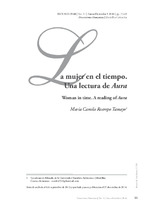Mostrar el registro sencillo del ítem
La mujer en el tiempo. Una lectura de Aura
| dc.contributor.author | Restrepo Tamayo, María Camila | |
| dc.coverage.spatial | Seccional Medellín | spa |
| dc.date.accessioned | 2021-02-08T20:49:57Z | |
| dc.date.available | 2021-02-08T20:49:57Z | |
| dc.date.issued | 2014 | |
| dc.identifier.uri | http://hdl.handle.net/20.500.11912/7988 | |
| dc.description | p. 55 - 69 | spa |
| dc.description.abstract | En su novela Aura, Carlos Fuentes reflexiona sobre el misterio de la condición femenina, rescatando cómo la mujer es quien vela en su amarga angustia, en su soledad acongojada, en el anhelo incansable que la acosa toda su vida; el de amar y ser amada. Por tal motivo, el presente artículo pretende evaluar ese elemento a través de la figura masculina, desde el vigor y el deseo que se somete lentamente a su presencia. En un principio se hablará sobre la figura femenina y masculina en Aura siguiendo el desarrollo de la obra, para posteriormente tratar el tema del amor desde la perspectiva de estos dos personajes y su relación con la ilusión y el tiempo. Finalmente se dará una interpretación de dicha obra en relación con la historia de México y ciertas nociones sociológicas que nos permitirán plantear una tesis actual de la significación de estos dos personajes (el hombre y la mujer) en nuestro tiempo. | spa |
| dc.description.abstract | Carlos Fuentes in his novel Aura reflects about the mystery of feminine condition. The present article pretends to focalize this mystery. It will evaluate the masculine figure that Fuentes presents; his vigor and his desire that are slowly subjugated by the presence of another character; is the women who veils in her bittering anguish, in her bereaved solitude, in her unreachable longing which persecutes her all her life; the desire to love someone and be loved. At the beginning, we will talk about masculine and feminine figure in Aura, following the development of the book, after that we will treat the theme of love in this two characters and his relationship with the illusion and the time. Finally, we will give an interpretation of the book in relationship with Mexico’s history and some sociological notions that will let us propose a thesis based in the signification of these two characters (the man and the woman) in our times. | spa |
| dc.format.mimetype | application/pdf | |
| dc.language.iso | spa | |
| dc.publisher | Universidad Pontificia Bolivariana | spa |
| dc.relation.ispartof | Pensamiento humanista | spa |
| dc.rights | Attribution-NonCommercial-NoDerivatives 4.0 International | * |
| dc.rights.uri | http://creativecommons.org/licenses/by-nc-nd/4.0/ | * |
| dc.subject | Aura | spa |
| dc.subject | Mujer | spa |
| dc.subject | Hombre | spa |
| dc.subject | Amor | spa |
| dc.subject | Historia | spa |
| dc.subject | Woman | spa |
| dc.subject | Man | spa |
| dc.subject | Love | spa |
| dc.subject | Time | spa |
| dc.subject | History | spa |
| dc.title | La mujer en el tiempo. Una lectura de Aura | spa |
| dc.title.alternative | Woman in time. A reading of Aura | spa |
| dc.type | article | spa |
| dc.rights.accessRights | openAccess | spa |
| dc.type.hasVersion | publishedVersion | spa |
| dc.description.sectional | Medellín | spa |
| dc.identifier.instname | instname:Universidad Pontificia Bolivariana | spa |
| dc.identifier.reponame | reponame:Repositorio Institucional de la Universidad Pontificia Bolivariana | spa |
| dc.identifier.repourl | repourl:https://repository.unab.edu.co/ |
Ficheros en el ítem
Este ítem aparece en la(s) siguiente(s) colección(ones)
-
No. 11 (2014) [12]


